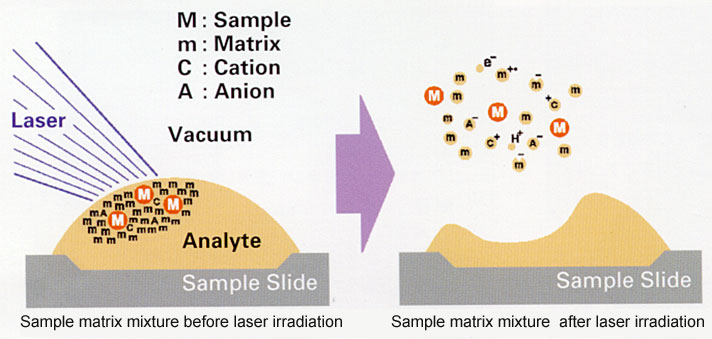Digital Ion Trap Mass Spectrometer
Despite its light and compact shape, the MALDImini-1 allows very high-sensitivity MSn measurements, making it suitable for a large number of applications.

Matrix Assisted Laser Desorption/Ionization.
MALDI is the abbreviation for "Matrix Assisted Laser Desorption/Ionization."
The sample for MALDI is uniformly mixed in a large quantity of matrix.
The matrix absorbs the ultraviolet light (nitrogen laser light, wavelength 337 nm) and converts it to heat energy. A small part of the matrix (down to 100 nm from the top outer surface of the Analyte in the diagram) heats rapidly (in several nano seconds) and is vaporized, together with the sample.
TOF MS is the abbreviation for Time of Flight Mass Spectrometry.
Charged ions of various sizes are generated on the sample slide, as shown in the diagram. A potential difference V0 between the sample slide and ground attracts the ions in the direction shown in the diagram. The velocity of the attracted ions v is determined by the law of conservation of energy. As the potential difference V0 is constant with respect to all ions, ions with smaller m/z value (lighter ions) and more highly charged ions move faster through the drift space until they reach the detector. Consequently, the time of ion flight differs according to the mass-to-charge ratio (m/z) value of the ion. The method of mass spectrometry that exploits this phenomenon is called Time of Flight Mass Spectrometry.

Despite its light and compact shape, the MALDImini-1 allows very high-sensitivity MSn measurements, making it suitable for a large number of applications.
The MALDI-8030 is the latest in a long line of MALDI-TOF products from Shimadzu.
The MALDI-7090 is targeted for proteomics and tissue imaging. It combines Shimadzu's extensive MALDI TOF-TOF mass spectrometry expertise with novel patented technology to provide ultimate performance in identification and structural characterization of biomolecules.
Download the latest brochure.
| Documents | Date Creation Date |
|---|---|
2024-09-27 | |
2020-06-24 | |
2018-06-12 |